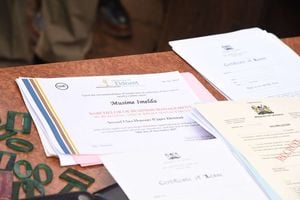
A user on the MyPower, Kenya Power android app, available on the PlayStore. It allows users to access a wide array of services, including bill enquiries, pre-paid meter queries, power quality reports and interaction with the customer care team.
| Diana Ngila | Nation Media GroupBusiness
Premium
Power cost still high, despite Uhuru promise
A promise by President Uhuru Kenyatta that the cost of electricity would progressively come down by 33 per cent, in the three-month period between October and December has not been kept, instead, the power now costs marginally more.
An investigation by the Nation reveals that, on the contrary, the cost of electricity went up in October and November, compared to previous months, as Kenyans continue paying for the failures of struggling monopoly Kenya Power.
Nation can confirm that electricity costs for domestic pre-paid customers (who pay using tokens) has risen by at least 3.33 per cent between early October and December 3, compared to the average charges between August and September.
Electricity charges between August and September -- before the President issued the order -- ranged between Sh17.85 and Sh17.86 per unit (pre-paid using Kenya Power Paybill), which rose to between Sh18.4 and Sh18.5 between October and December.
Domestic customers
While the average cost of electricity for domestic customers was Sh17.855 per unit between August and September, the same rose to Sh18.45 between October and early December, Nation has established through a review of electricity payments through the period.
The same has been established from commercial heavy energy users who also say there has not been any reduction in their power costs.
“So far what we have witnessed has been the reorganisations and reforms happening within government agencies involved in energy such as Kenya Power and Kenya Electricity Transmission Company (Ketraco) as well as steps for renegotiation of Power Purchase Agreements (PPAs) that made power costly,” said Kenya Association of Manufacturers (KAM) chief executive Phyllis Wakiaga.
Ms Wakiaga told Nation that manufacturers have not seen any changes in costs, and KAM’s push to have electricity charges for the sector range at Sh11 per kilowatt, so that Kenyan manufacturers can be competitive in the region, continues.
Nation also saw power payment records by one manufacturer for September and October, where there were normal marginal changes, but bills above Sh600,000 each month.
“So far we have not seen costs coming down, but we believe that the activities we have seen happening recently are geared towards achieving that,” she said.
High costs
Following a presidential task force investigation on the reasons for high costs of electricity, Kenya Power’s involvement in expensive and uncompetitive power purchase deals with Independent Power Producers (IPPs) was identified as the main cause.
The task force recommended a raft of measures to ensure the issue was rectified, including renegotiation of terms between the utility firm and IPPs, and changing of contracts that were unfavourable to the company.
When the President received the report on September 29, he ordered the Energy Ministry to secure the immediate implementation of all the recommendations “by Christmas Day, 2021”.
“The President has also examined and welcomed the recommendations of the task force that establish a path towards the reduction of the cost of electricity by over 33 percent within four months,” a communication from State House stated.
“Despite all efforts to streamline the company, the cost of electricity threatens the financial sustainability of the company and will continue to do so unless deliberate measures are implemented to reduce the cost and to restructure the PPAs,” Kenya Power Chairperson Vivienne Yeda said during the company’s Annual General Meeting (AGM) on Friday.
Even though the board and top management of Kenya Power maintained they were on a path to restructure the firm and reduce costs, it was not clear when that would be effected.






